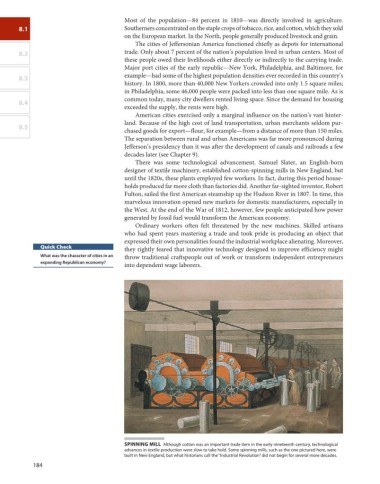Page 217 - American Stories, A History of the United States
P. 217
Most of the population—84 percent in 1810—was directly involved in agriculture.
8.1 Southerners concentrated on the staple crops of tobacco, rice, and cotton, which they sold
on the European market. In the North, people generally produced livestock and grain.
The cities of Jeffersonian America functioned chiefly as depots for international
8.2 trade. Only about 7 percent of the nation’s population lived in urban centers. Most of
these people owed their livelihoods either directly or indirectly to the carrying trade.
Major port cities of the early republic—New York, Philadelphia, and Baltimore, for
8.3 example—had some of the highest population densities ever recorded in this country’s
history. In 1800, more than 40,000 New Yorkers crowded into only 1.5 square miles;
in Philadelphia, some 46,000 people were packed into less than one square mile. As is
common today, many city dwellers rented living space. Since the demand for housing
8.4
exceeded the supply, the rents were high.
American cities exercised only a marginal influence on the nation’s vast hinter-
land. Because of the high cost of land transportation, urban merchants seldom pur-
8.5
chased goods for export—flour, for example—from a distance of more than 150 miles.
The separation between rural and urban Americans was far more pronounced during
Jefferson’s presidency than it was after the development of canals and railroads a few
decades later (see Chapter 9).
There was some technological advancement. Samuel Slater, an English-born
designer of textile machinery, established cotton-spinning mills in New England, but
until the 1820s, these plants employed few workers. In fact, during this period house-
holds produced far more cloth than factories did. Another far-sighted inventor, Robert
Fulton, sailed the first American steamship up the Hudson River in 1807. In time, this
marvelous innovation opened new markets for domestic manufacturers, especially in
the West. At the end of the War of 1812, however, few people anticipated how power
generated by fossil fuel would transform the American economy.
Ordinary workers often felt threatened by the new machines. Skilled artisans
who had spent years mastering a trade and took pride in producing an object that
expressed their own personalities found the industrial workplace alienating. Moreover,
Quick Check they rightly feared that innovative technology designed to improve efficiency might
What was the character of cities in an throw traditional craftspeople out of work or transform independent entrepreneurs
expanding Republican economy?
into dependent wage laborers.
sPinninG MiLL Although cotton was an important trade item in the early nineteenth century, technological
advances in textile production were slow to take hold. Some spinning mills, such as the one pictured here, were
built in New England, but what historians call the “Industrial Revolution” did not begin for several more decades.
184

